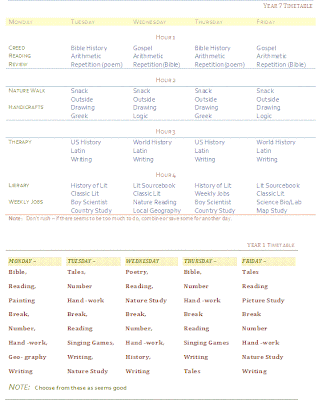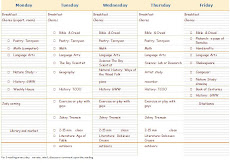
My favorite organizational tools recently -- my box of books, and my binder.
As for the box:
All the folders and binders and my books that I'm studying are in one place, so I'm not hunting all over the house or lugging big piles everywhere. I have my two binders (one for homeschool, one for general organization), my folders for this year, and my current books: Spiritual Exercises, Charlotte Mason's Home Education, Plato's Republic, The Intellectual Life, Wheelock's, and Norms and Nobility, along with a couple of others. This doesn't count the library books I'm reading -- it's just the ones I'm working at on a more longterm basis or want at hand for easy reference.
As for the binder:
I like the way I can write things that come up and then transfer them to the right places so I can have things together -- all the progym ideas in one place, Charlotte Mason book study in another, and so on.
I am simply writing down things as they come into my mind and putting them into the binder organized under various topics. I didn't plan the topics right away --- I made them up after I already had a sheaf of papers to organize. A pattern started to show up and after a couple of slight revisions, I had these categories:
- Devotional Journal (right now I'm going through St Ignatius' Spiritual Exercises)
- Daily To-Do Lists (I keep a running list of things I have to remember or get to -- this is where I file them once that day is past -- it is based on GTD which is helpful for my kind of mind because I just list them, I don't short-circuit my ADD brain trying to prioritize or sort them)
- Book Notes (thoughts about various books I'm reading)
- Thoughts (just miscellaneous things that don't fit anywhere else -- things I'm working through, things I might blog about someday, that sort of thing)
- Resource Lists (here is where I've been putting lists and procedure -- some examples are -- a list of activities for the little ones, to bring out when they seem at loose ends; some lesson planning procedures; a morning routine)
- Subject Resources -- (notes on specific subjects -- like how I plan to approach Latin, Nature Study, Math, Classical Writing, etc)
- Active Projects
To explain that last category, which is actually the first in my binder -- I keep the present day's list of things to do in the front of the binder, and behind it I keep separate sheets for various projects that are in "active" status. For example, right now I have a sheet for our car, because it is in the shop with a broken transmission. I put details about phone calls, rental car information, cost of repair, and so on, all on that one page. When the car is back I'll put that sheet in some sort of record-keeping category.
Another active "project" is going through all the past school-related materials that are still unfiled in my closet. That is what this next picture is about:

I usually have an organizational backlog from the school year which I address during the summer months. It gives me a chance to see progress, reflect on how to do things for next year, note down ideas that worked in the past which I had forgotten, and in general review the past year (or two!). I am categorizing the materials I find into these categories:
- Past schoolwork and other personal mementos, to organize and file.
- Past lesson plans, resource documents, learning ideas that I plan to go through more carefully after I've done the basic organizing.
- Trash -- junk I don't need any more.
- Half-empty spirals -- I tear out the filled pages and put them into one of the three categories above. Then I save the half-used spirals for the little guys' drawing sprees.... they like to have a "book" like their older siblings have.
 Maybe I should keep them, seeing as they are working for one kid, though not in the way planned. He just loves reading the numbers and talking about how X + Y = (6+7) squared, and so on.
Maybe I should keep them, seeing as they are working for one kid, though not in the way planned. He just loves reading the numbers and talking about how X + Y = (6+7) squared, and so on.














